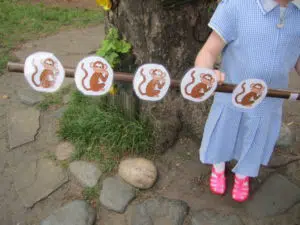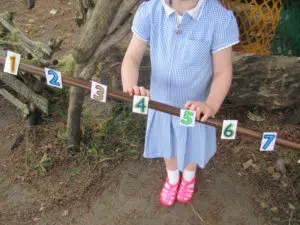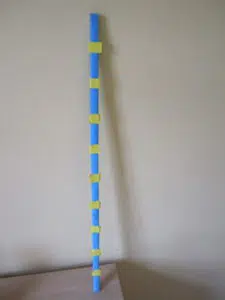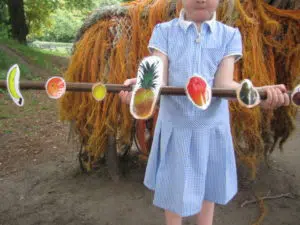Counting sticks are one of the most versatile tools to teach a range of skills in maths. It is also a simple resource that can be used very effectively with children aged between 3 and at least 11, and maybe higher. There is no end to its versatility, as well as its simplicity.
But how do you first introduce a counting stick to young children? And how do you get children with a very short attention span to engage with this resource and start out on the right path?
Counting sticks can be used to teach simple maths in a range of ways. You can put stick simple pictures on to it, and use alongside counting songs. You can place numbers on the stick and use a toy to jump along them, getting the children to count in a range of ways.
Counting sticks are fantastic for counting forwards and backwards, and for counting on from a given number. You can also order numbers. It is a great introduction to a number line for very young children.
The more child-friendly you make the first counting sticks they encounter, the more children will be excited to find out the possibilities that they offer. Here are some of my favourite ways of bringing counting sticks successfully into the early years.

First make or buy a stick
Simple counting sticks can be bought quite cheaply from Amazon. This is what the bought ones look like:

Alternatively, you can make your own. Any second-hand pole will do the job. Old broom handles make perfect counting sticks. You can varnish or wax them to make them look even more ready for action.
I like to stick velcro onto my counting stick, particularly when I start using it with very young children.
I stick eleven pieces of velcro at equidistant intervals along the length of the stick. There are eleven pieces of velcro because you can then stick the numbers from 0 to 10 on to make a simple number line.
Here is what my counting stick looks like:

1. Use it with a number song
This is probably my number one favourite way to first introduce a counting stick to very young children.
The counting stick acts in a similar way to a number bag. Have some pictures that you put onto the pole.
For example, here are the five monkeys in Five Little Monkeys Jumping on the Bed:

Before the song, you ceremonially put them on and count them. Then you sing the song, and jump off the bed! When you have sung, one little monkey is removed – you have one less! How many do we have?
Continue throughout the song. It is a very simple visual representation of the quantities in the song, that works hand-in-hand with counting on the fingers.
It is also a great starting place for mathematical language such as less, fewer, more, smaller etc.
If you’re looking for counting songs that count upwards (and there aren’t that many!) then check out this article about ten examples.
2. Stick numbers on to create a simple number line
This is another simple way to get children started with counting sticks. It could also be their first experience of a number line – and number line that can be manipulated and simplified as much as if required.
I would start with either 1 to 3, or 1 to 5. Put the numbers in order on the stick, and say to the children we are going to count up the stick. Follow my finger! 1, 2, 3…

3. Follow the toy
Use a toy for the children to follow with their eyes.
I like to use a winged horse, but any small toy that is visually engaging will work. Say when the toy lands on a number say the number. Start simply, and land on 1,2,3…with the children saying the numbers with you.
When they get a bit better, you can try going forwards then backwards, or landing on random numbers (check out the 18 best counting backwards games here).
4. Follow the finger puppet
A similar idea is use a finger puppet. Any engaging character will work.
If you are doing The Three Little Pigs, why not use a little pig?
You can all use your little pig voices when you count then. You could use the Big Bad Wolf and count in ferocious wolf voices. Counting and silly voices go well hand-in-hand, so try counting like aliens, robots, princess etc etc.
5. Dress the stick
This is one of my favourite ways of using a counting stick when you are ready to take it to the next level.
To ‘dress’ the stick, you cover in something, usually coloured paper.
For example, you can cover it in black paper, and stick stars at equal distances along it. You can then say something like it’s an alien counting stick sent from outer space by the super alien. He wants us to get great at counting!
Adding a bit of drama and a back-story to any resource really helps with engagement.
Other good examples I have used are making a super-hero counting stick, making a dog-counting stick for hairy maclary, and making a spider counting stick for halloween. However, you really can be as creative as you want.
Having a relevant prop to help you count is good as well. For example, have a witches finger for the children to follow as you go up and down the halloween stick. Here is a simple superhero counting stick:

You do not need to spend hours creating a masterpiece! Time is precious enough working in modern education. I say this to lots of people – the early years is not a photo-shoot!
Usually a simple creation with a bit of a backstory (e.g. the superhero has sent it to us from outer space), will always out perform something that has taken hours to create but is not introduced with the same level of imagination.
6. Holding a counting stick with no numbers on.
When I first introduce the number stick without numbers I will always show the children that one end of the stick is 0. The other end is ten. I always hold it in the middle, and I say that this is 5.
7. Counting on the dressed stick
Now you have got a dressed stick, and the children have got some basic skills, it’s time to mix up the ways you count a bit.
Children are programmed like robots when it comes to counting.
They are usually great at counting from 1 upwards, but if they have to start from a different number, or not count in a straight line they don’t know what to do.
The more flexibility you can get into their counting the better, and the more easily they will be able to access calculating later on.
The ability to rote count in many different ways is crucial in early maths.
One simple way to introduce flexibility is go up and down the stick in random moves. For example, using your toy or finger puppet, slowly move like this…1,2,1,2,3,4,3,4,5,6,5,4,5,6,7…Get the children to say the numbers with you as you move.
8. Boomerang
In Boomerang you can either use a laminated cut-out picture of a boomerang, or just some other object to indicate the boomerang.

You could also just use your finger. In this game you stick the boomerang (or your finger) at one of the counting stick. You then help the children to count upwards to that point and then backwards from it back to zero.
Again, children are programmed like robots when it comes to counting.
Many can count back from 5 easily, but counting back from 4 can actually be harder because they haven’t been programmed in the same way with all the counting songs that exist that count back from 5 or 10.
When you’ve tried one number, simply try another, and continue.
9. Count in different voices
Using different voices is a great way to jazz up any counting activity, and I also like to use them in early phonics as well. It just gets children engaged and more involved.
I wouldn’t do this all the time, but just something to freshen up the experience of using a counting stick occasionally.
You choose a special voice, like for example an alien, and then just try all counting like aliens using the other counting games described in this post. Other good voices to use are robots, princesses, bears, ghosts and zombies.
Using interesting voices is one of the ultimate counting games (check out my favorite 17 here)
10. Start from a point not zero
This is a harder skill, but a good next step. This again works on the idea that it is harder to start counting from any point other than one, but that this is a very necessary skill when trying to calculate.
Say to the children something like ‘Today this end of the counting stick is going to be 3, and the other end is 13. (It is always ten more, and some of the children will start to realise this after a few goes) My finger will be on 8.’ Then start counting in different ways…3,4,5,4,5,6 etc
Counting on from a given number is another key early skill.
11. Stick pictures on
Counting sticks are fantastic for linking with maths stories and number stories (to find out what number stories are then go here). For example, a book like Handa’s Surprise works really well.

You can create pictures of all the fruit found in the story, laminate and then stick onto your counting stick.
For those not familiar with this story, it is about a girl that walks with a basket of fruit on her head.
Every page an animal steals a piece of fruit out of her basket. You start with lots of fruit on the stick, but as the story goes on, there is one less every time you take a piece off.
As a piece of fruit gets robbed, take it off the stick. Count how many are left and emphasize that this is one less.
This is a great way for teaching ‘one less’ in a real-life context. Many other books can be used in a similar way to teach concepts of counting, one more, one less and even simple addition and subtraction.
12. Use it horizontally or vertically
It is great for children to experience number lines in a wide range of visual ways. It’s a good idea to sometimes hold the stick vertically, and go and up it or even down it.
Number lines can go in any direction. There is no need for them to go left to right like written text.
13. Guess the number
I like to do a funky chant with this one. We all sing ‘Guess the number! Guess the number!’ (Use whatever tune you think).
I will tell them the start of the stick is 0 and the end 10. Then place your finger (or a puppet) at one of the intervals down the stick. The children have to guess what number it is.
You can give them clues like ‘This is one more than zero. This is one less than five’. This game gives them a good visual idea of where numbers feature on a number line.
14. Show a number on number fan/write it
This is a bit of a next step when children are getting good at many of the strategies described in this post. Play one of the games suggested such as ‘guess the number’, or play a game where you all count but miss one number out.
Get the children to either write the number or show you on a number fan. Good for engagement, and seeing who is getting the idea and who isn’t.
15. Count in 10s or 2s
If your children are beginning to learn how to count in 10s or 2s, then a counting stick can really help this process.
Tell them that each line on the stick today is going to be ten. To start with you can simply go up the stick…10,20,30 etc.
However, it is good to start to vary it as well.
For example, get them to follow a toy and go 10, 20, 10, 20, 30, 40, 30 etc. This can be applied for 2s, 5s or even harder times tables as the need arises.
16. Make your own.
Art and maths often go really well hand-in-hand.
Children love making their own counting sticks out of sticks, branches, pieces of dowel or some other similar material. They can stick things on them, wrap or weave cotton or string round, and just generally jazz them up.
It is good for children to take ownership of the materials they use to learn, and this is one way of introducing counting sticks into their play.
17. Attach To Walls Or Fences
When children become confident at using a counting stick, why not let them try it completely independently?
Conclusion
In conclusion, counting sticks are one of the most valuable, cheap and versatile tools that exist to develop simple maths skills in a wide range of areas.
By adding a bit of drama, toys, finger puppets, funny voices, dressing them up, and just generally using a spectrum of child-friendly strategies, children’s engagement is heightened and their introduction to counting sticks is a positive experience, setting them up well for future maths experiences.
If you’ve found this useful, why not check out one of these articles:
